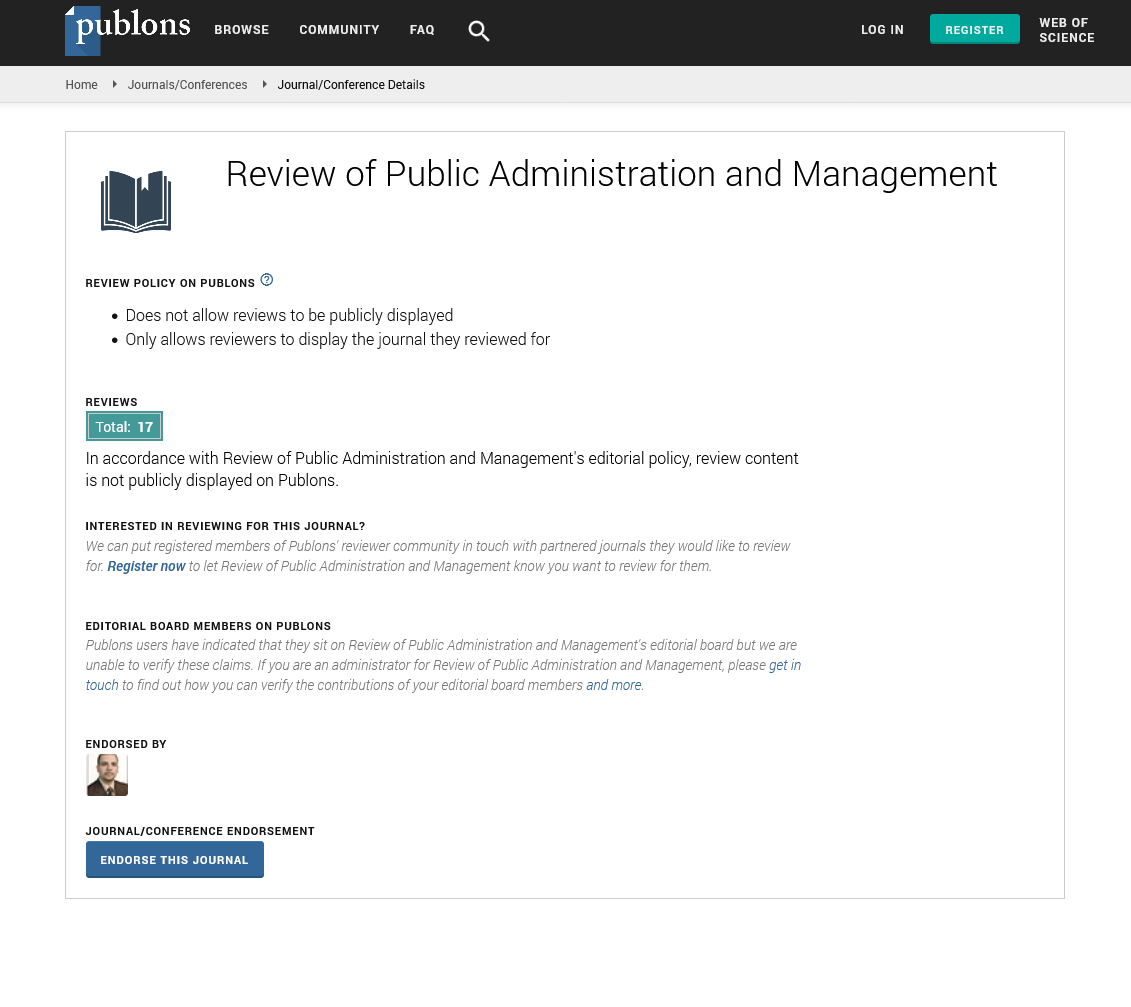Indexed In
- CiteFactor
- RefSeek
- Directory of Research Journal Indexing (DRJI)
- Hamdard University
- EBSCO A-Z
- Scholarsteer
- Publons
- Euro Pub
- Google Scholar
Useful Links
Share This Page
Journal Flyer

Open Access Journals
- Agri and Aquaculture
- Biochemistry
- Bioinformatics & Systems Biology
- Business & Management
- Chemistry
- Clinical Sciences
- Engineering
- Food & Nutrition
- General Science
- Genetics & Molecular Biology
- Immunology & Microbiology
- Medical Sciences
- Neuroscience & Psychology
- Nursing & Health Care
- Pharmaceutical Sciences
Commentary - (2025) Volume 13, Issue 2
Citizen Participation in Public Decision Making
Wei Zhang*Received: 02-Jun-2025, Manuscript No. RPAM-25-29751; Editor assigned: 04-Jun-2025, Pre QC No. RPAM-25-29751; Reviewed: 17-Jun-2025, QC No. RPAM-25-29751; Revised: 21-Jun-2025, Manuscript No. RPAM-25-29751; Published: 28-Jun-2025, DOI: 10.35248/2315-7844.25.13.487
Description
Citizen participation has become an increasingly important theme in the study and practice of public administration. Historically, governments viewed citizens as passive recipients of services, expecting compliance rather than active involvement. Over time, however, the recognition has grown that sustainable governance requires meaningful interaction between citizens and administrative institutions. Participation is not only a democratic right but also a mechanism for improving the quality of decisions, enhancing accountability and strengthening social cohesion. The concept has been applied in various forms across the globe, from local consultations to participatory budgeting, each providing valuable lessons for the theory and practice of public administration. In China, several municipalities have experimented with participatory budgeting, offering citizens the opportunity to allocate small portions of the local budget. Though modest in scale, these experiments reveal the potential of citizen engagement to transform attitudes toward administration. Citizens who once viewed local government as distant and unresponsive began to see themselves as contributors to community development. For example, in a district of Beijing, residents were given the choice to prioritize funding for playgrounds, elderly care centers, or environmental clean-up projects. The resulting discussions not only improved the alignment of spending with local needs but also enhanced the legitimacy of decisions. When people feel that their voices influence outcomes, they develop a stronger sense of belonging and responsibility toward the community.
Brazil provides another prominent case through its long-standing tradition of participatory assemblies. In cities like Porto Alegre, ordinary citizens gather annually to debate and decide on municipal spending priorities. This process empowers communities that might otherwise be marginalized in traditional decision-making structures. While participatory budgeting requires significant time and organizational effort, it demonstrates that involving citizens can lead to more equitable and widely supported outcomes. International studies have shown that participatory budgeting in Brazil has led to increased investments in health, education and sanitation, areas often overlooked by elites. Technology has added a new dimension to participation. Online platforms and mobile applications allow citizens to express opinions, submit complaints and suggest policies without attending physical meetings. In countries like Estonia and South Korea, digital consultations have become integral to policy formulation. Citizens can vote on proposals, comment on drafts and interact with officials in real time. These tools have lowered barriers to participation, particularly for younger generations and working individuals with limited free time. However, technology also raises challenges of access and representation. Not all citizens have equal digital literacy or reliable internet connectivity. This creates a risk of excluding vulnerable populations, thereby reinforcing inequality rather than reducing it. To address this, governments must complement digital participation with traditional in-person forums to ensure inclusivity.
The effectiveness of citizen participation depends heavily on how seriously administrators take public input. Symbolic exercises where citizen opinions are collected but ignored can backfire, generating cynicism rather than trust. Participation must be integrated into actual decision-making processes. This requires institutional mechanisms such as formal committees, legal mandates for consultation, or clear procedures for incorporating public feedback. In the absence of such mechanisms, participation risks being reduced to mere tokenism. Another challenge is balancing inclusiveness with practicality. Large-scale participation often leads to domination by vocal groups, while quieter or marginalized voices remain unheard. For instance, neighborhood associations may be dominated by middle-class residents with time and resources, while poorer citizens are underrepresented. Strategies to mitigate this include targeted outreach, capacity-building programs and facilitation techniques that encourage equal participation. Administrators must be trained to manage these dynamics carefully, ensuring that decision-making reflects the diversity of the community rather than the interests of a few.
Participation is not only valuable for improving decisions but also for building trust and compliance. When citizens feel included in shaping policies, they are more willing to abide by rules and support public programs. For example, environmental regulations gain higher compliance rates when communities are consulted during their design. Farmers who participate in discussions about water management policies are more likely to adopt conservation practices, as they perceive the rules as fair and responsive. This illustrates that participation has both normative and instrumental value: it strengthens democracy while enhancing administrative effectiveness. International comparisons reveal that participation must be adapted to cultural and institutional contexts. In some societies, consensusbuilding and group harmony are emphasized, making participatory processes naturally compatible with social norms. In others, adversarial debate is more common, requiring structured forums to manage conflict productively. China’s experiments show that even within centralized political systems, limited forms of participation can produce positive outcomes when carefully designed. Conversely, experiences in some Western democracies highlight the risks of public fatigue if participation is excessive or poorly organized.
Citizen participation also evolves with time. Initial enthusiasm may wane if citizens do not see tangible results. Therefore, sustaining participation requires regular feedback loops where governments report how citizen input influenced decisions. Communication is vital; without it, citizens may conclude that their contributions were ignored. Governments that publish reports, hold follow-up meetings, or provide visual updates of completed projects demonstrate responsiveness and reinforce the value of participation. The role of civil society organizations is also critical. Non-governmental organizations, community associations and advocacy groups often act as intermediaries, helping citizens articulate their concerns and navigate bureaucratic procedures. Their involvement can broaden participation by reaching marginalized groups. However, reliance on civil society also has risks if certain organizations dominate the process or pursue narrow agendas. Balanced partnerships between government and civil society are essential to maximize benefits while minimizing distortions.
In conclusion, citizen participation is not a panacea but a vital component of effective public administration. It enhances legitimacy, improves decision quality, builds trust and fosters a sense of shared responsibility. The experiences of China, Brazil and various digital democracies demonstrate both opportunities and challenges. Effective participation requires serious commitment from administrators, inclusiveness, adaptability to cultural contexts and sustained feedback mechanisms. In the modern era, where trust in governments faces constant pressures, citizen participation offers a pathway to re-establish meaningful connections between state and society. Its success ultimately depends on the willingness of both citizens and officials to engage in genuine dialogue and collaboration.
Citation: Zhang W (2025). Citizen Participation in Public Decision Making. 13:487
Copyright: © 2025 Zhang W. This is an open-access article distributed under the terms of the Creative Commons Attribution License, which permits unrestricted use, distribution and reproduction in any medium, provided the original author and source are credited.


